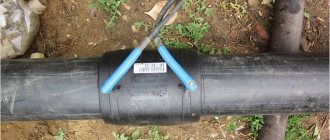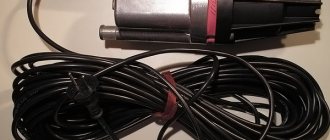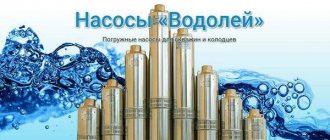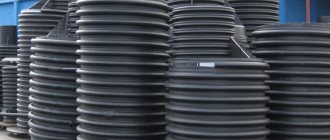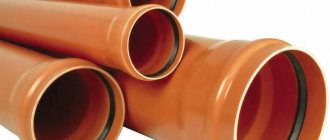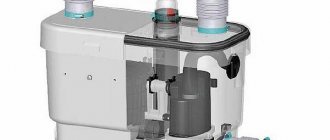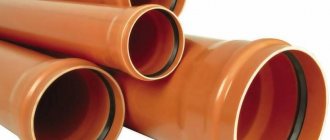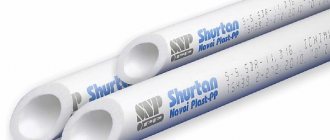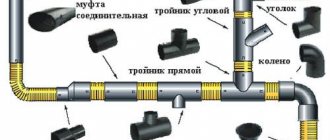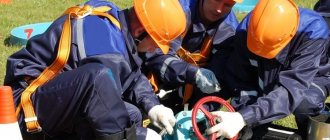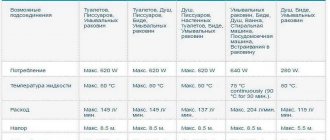Polyethylene water pipes can be used to carry almost all types of liquid because they do not react with most substances. Such products are widely used for laying both cold and hot water supply lines (with a carrier temperature of up to 40 ° C) in a private home or country house (especially in the ground). When installing pressure pipes, permanent and detachable connections are used.
HDPE pipes are used for laying water pipelines for various purposes
Main features of the material
Ethylene is an organic compound used in the chemical industry. It is used to produce polyethylene (PE) by polymerization. There are 2 technological processes:
- Production of low-density polyethylene (HDPE) at a temperature of 120-150°C and a pressure of 0.1-2 MPa.
- Production of high-density polyethylene (HDPE) at a temperature of 200-260°C and a pressure of 150-300 MPa.
HDPE (or HDPE - High Density Polyethylene) has high strength and density. LDPE (or LPDE - Low Density Polyethylene) is a low-density material characterized by softness, ductility, and ductility.
Technical HDPE pipes can be used in the country for sewerage networks, drainage, as protective ducts, for laying electrical cables, etc. HDPE water pipes are black, this is their distinctive feature.
When laying a water supply network in the ground at a dacha, it is necessary to ensure that the depth of the trench is lower than the freezing point of the soil, and the width is the minimum required for the location of the pipe.
Pipes made of low-pressure polyethylene are suitable for laying underground water supply in a country house.
Note! It is optimal to place a section of the pipeline in the ground that does not have connections.
HDPE. What it is?
The abbreviation stands for low-density polyethylene. The pipe is made using extrusion technology: pressing molten raw materials through a mold. The production method includes the following steps:
The initial polymer raw material is loaded into an extrusion hopper, where it melts under the influence of high temperatures. At this stage, additives are added to improve the performance properties of the finished product.
The hopper maintains a given pressure, which promotes compaction of the material: individual molecules are converted into a monolithic crystalline network.
The molten raw material passes through the extrusion head, cooling and taking on a marketable cylindrical shape.
After this, the blanks are fed to a sizing mill, where they are processed to the specified diameter.
At the final stage, markings are applied and the pipes are cut to lengths convenient for storage and sale.
There are 2 groups, depending on the area of application:
Pressure – water supply, heating and sewerage systems.
Gravity casing products that are suitable for high-voltage cables, drainage systems and water intake wells.
Production of polyethylene pipes
The production of polyethylene water pipes, the technical characteristics of which are determined by the properties of the material and the choice of technology, is based on three different methods:
- suspension;
- mortar;
- gas phase.
With the first technology, the monomer is polymerized in a dispersion medium (most often water). This process is accompanied by the formation of a suspension with particle sizes from 50 to 150 nm. The solution method is similar to the previous one, but polymerization takes place in an organic solution. Gas-phase technology involves the appearance of a gas phase of the monomer.
All three methods make it possible to obtain a high-strength material with strong intermolecular bonds due to the low level of molecular branching. The technical characteristics of polyethylene and its structure depend on the type of technology used.
Depending on the nominal pressure, polyethylene pipes are available in 7 versions: SDR-9; SDR-11; SDR-13.6; SDR-17; SDR-17.6; SDR-21 and SDR-26.
Technologies for the production of HDPE pipes make it possible to obtain products with different wall thicknesses for different types of pipelines
Methods for connecting polyethylene pipes
These products are the product of modern technologies and are subject to increased requirements. Their docking remains vulnerable. Polyethylene water pipes can be connected in various ways:
- By welding. In this case, the use of a special welding machine is mandatory. It is necessary to achieve smooth edges of the joined products. The quality of the joining depends on the correctness of their heating to the required temperature and bonding with each other. This option is well suited when laying a pipeline in the ground. There is no need to maintain such structures.
- Using compression fittings. There is a huge variety of connecting elements with which you can assemble a pipeline of any degree of complexity. The disadvantage of this method is its periodic maintenance. Thus, placing it in the ground is not recommended. However, it can be disassembled and reassembled in another structure if necessary.
- Using electric diffusion welding and special connecting fittings. Such connecting elements have their own individuality, which consists in the presence of a heating coil and corresponding sensors. On their surface there are terminals to which a special welding machine is connected. The edges of the products must first be prepared and inserted into the fittings. The welding machine independently reads the applied barcode, as a result of which the spiral heats up to the required temperature and melts the material of the fitting and pipe, thereby tightly fastening them together. This connection does not require maintenance and can be buried in the ground. This is a good option when combining several types of material in one pipeline.
- Using flange connection. This is a good method for joining plastic products with cast iron products with a diameter of more than 50 mm. It requires maintenance, so it is not recommended to place it in the ground.
Product requirements
HDPE pipes for water supply are products that are made of polyethylene with a diameter of 1-120 cm at a low pressure value (0.1-2 MPa). Their production complies with GOST 18599 – 2001.
Regulatory documents define the technical and operational characteristics and standards for HDPE water supply pipes:
- The outer, end and inner surfaces must be smooth without cracks, foreign inclusions or cavities.
- The maximum withstandable operating pressure is up to 16 or 20 atmospheres.
The diameters of HDPE water pipes that meet the above requirements can vary from 1.6 to 160 cm. Such products are supplied in the form of coils of 200 and 100 meters or in the form of straight sections of 12 m.
The HDPE pipe is marked with blue stripes (at least 3), evenly distributed around its circumference. The operating temperature of the products is from -20 to +40 °C. Maximum temperature values for PE water pipes are from -70 to +80 °C. The tensile strength of the products is 38 MPa.
Pipes are tested for quality compliance with accepted standards
Pipe laying
Often, HDPE pipes for water supply are laid underground. The products are mainly used to supply water from a well to the boiler room of a private house. They are also used to supply water to the house from the central water supply system. To lay part of the pipeline underground, it is necessary to dig a trench. If you do this by hand, dig a trench 25 cm wide, i.e. the width of the shovel. If the trench was equipped with an excavator, in this case the width does not matter, as long as it is at least 25 cm.
The depth of the trench is an equally important factor. The degree of soil freezing depends on it. In the central federal part of Russia, it is recommended to dig trenches to a depth of at least 1.6 meters. Dig the trench a little deeper to place a bed of sand at the base. The cushion is recommended for soil compaction to prevent bending of the pipeline under load. It is advisable to dig a trench with a flat bottom.
After the trench is ready, lay the pipe (at the bottom). Then the initial connection is made, or the pipe is pressure tested to check its tightness. If the HDPE pipe is new, inspection is not necessary. It is also recommended not to fill the trench until the connection is complete. Since connecting a special coupling may require a slight shift in the structure. Therefore, if you fill the hole with earth immediately, this possibility will no longer exist. They usually fill it with the same soil that they dug up, but experts recommend filling it with denser material. For example, sand or gravel.
Characteristics of HDPE pipes that determine their choice
There are three main parameters for HDPE pipes:
- brand of polyethylene;
- SDR indicator;
- diameter.
There are 3 brands of polyethylene: PE-63, PE-80 and PE-100. PE-80 products are distinguished by their ability to withstand significant internal pressure. They are well suited for water pipes with a cross-section of up to 9 cm. PE-100 water pipes are used for laying cold water supply systems in the country and are made on the basis of PE-80.
Such products can provide the required throughput with a smaller diameter. Pipes made of PE-100 are characterized by a maximum tensile strength at internal tensile strength of 1 thousand hours and resistance to mechanical stress. The SDR indicator is determined by the ratio of the pipe diameter to the wall thickness. For HDPE products for plumbing, a lower SDR value means higher strength of the products.
Helpful advice! For private use in the country, the diameters of HDPE water pipes for cold water supply of 25 or 20 mm are sufficient. If the daily water consumption is large (for example, for watering a garden), then you can take pipes 3.2 cm in diameter.
To install a water supply system in a country house, HDPE pipes of small diameter are sufficient.
HDPE pipes for hot and cold water supply
Polyethylene pipes intended for installation of water supply systems differ from HDPE products for other purposes in bright blue, dark blue or black.
In addition to color, there are differences in technical characteristics:
- For water supply networks, pipes with a density coefficient from 63 to 100 are used, with PE-63 used for cold water supply networks, PE-80 for hot water supply, and PE-100 for main pipelines.
- Water is supplied to the pipelines under pressure; water hammer can occur in the network, so you should choose components with a minimum SDR.
- Hot supply networks can be made from any water pipes, and for drinking water it is permissible to use only products made from food-grade polymer - such pipes are marked with blue longitudinal stripes or completely painted blue.
- Black components without longitudinal markings can be made from recycled materials, so it is not advisable to use them for arranging a drinking water supply network.
Note! To supply hot water, you can use more expensive reinforced HDPE pipes with additional PN markings. Such pipes are also called two-layer: one layer is HDPE, the second is foil, steel threads, PVC or fiberglass.
Technical characteristics of polyethylene products
Technical characteristics of HDPE pipes for water supply are given in the table.
Table 1
| Diameter, mm | 40 | 32 | 25 | 20 |
| SDR | SDR9/SDR11 | |||
| Wall thickness, mm | 4,5/3,7 | 3,6/3,0 | 2,8/2,3 | 2,3/2,0 |
| Maximum working pressure, MPa | 1,6/1,25 | |||
| Weight of 1 linear meter, kg | 0,3-0,5 | 0,2-0,3 | 0,15-0,2 | 0,12 |
Technical indicators for pipes of all brands and sizes are indicated on average in the table.
table 2
| Index | Meaning | Unit |
| specific heat | 2300-2700 | J/(kg*K) |
| melting temperature | 120-135 | °C |
| frost resistance | -70 | °C |
| density | 948-960 | kg/m3 |
| melt flow | 0,1-15 | g/10 min |
| tensile yield strength | 0,019-0,026 | GPa |
| Breaking stress | ||
| when stretched | 0,018-0,032 | GPa |
| when compressed | 0,02-0,036 | GPa |
| when bending | 0,02-0,04 | GPa |
| Elastic modulus | ||
| when bending | 0,636-0,735 | kPa |
| when stretched | 0,61-0,75 | kPa |
| water absorption per day at 23 °C | 0,01 | % |
| coefficient of thermal conductivity | 420-440 | mW/(m*K) |
| degree of crystallinity | 70-85 | % |
Advantages of pressure water pipes made of polyethylene
Polyethylene products have advantages over other types of pipes made of metal, cast iron or concrete. They have a long service life (50 years), are resistant to corrosion and aggressive environments, which makes them the best choice for use in the country. A polyethylene water pipe is 3-4 times lighter than a metal or cast iron pipe.
Speed and ease of installation are achieved by using thermistor fittings and reducing the cost of butt welding. In addition, the production of polyethylene pipes for water supply with a cross-section of 2-11 cm in coils that can accommodate a length of 50-1000 m allows reducing the amount of consumables.
Both above-ground and underground water supply systems can be installed from HDPE pipes
The characteristics of the products make it possible to install them in the ground at the dacha, which is due to their high elasticity and ability to withstand changes in soil load. There is no need to insulate a polyethylene water pipe, since it is frost-resistant and can be operated at temperatures down to -70 °C.
Note! The hydraulic properties of the water supply system are preserved if you use pressure polyethylene products with an order of magnitude smaller diameter due to their internal surface with low roughness.
HDPE pipe has a relatively low elastic modulus, which significantly reduces the risk of water hammer. Polyethylene pressure water pipes are toxicologically and bacteriologically safe.
Why is the correct internal diameter of pipes important?
The internal diameter of HDPE pipes is one of the most important indicators. In standard markings, this parameter is not always indicated, and to calculate it, you need to subtract the wall thickness from the size of the outer diameter. The amount of liquid passed through the system depends on the size of the internal diameter. For example, the larger the internal diameter of a water pipeline, the greater the amount of water that can pass through it at a time.
You should know!
Selecting the correct pipe parameters is very important to determine the scope of their use and installation method. PE100 pipes have the most optimal reliability indicators and are easy to weld. Although the production of this type of pipe is more expensive than products of other brands, due to the high strength of polyethylene, the wall thickness is reduced, which makes the purchase of PE100 more profitable.
